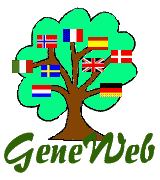

|
GeneWeb - Consanguinity |
The genes are placed in precise locations named "locus". Each individual has for each locus two genes, one transmitted by his mother, the other by his father, and transmits to his children a copy of the one of his genes.
The Consanguinity of an individual x is the probability cg(x) to find in a given locus two identical genes.
The Relationship of two individuals x and y is the probability pr(x, y) to find in the same locus two identical genes.
1
---- (1 + cg a)
n+1
2
where n is the length (distance x..a + distance
a..y) of the relationship link x..a..y.
The relationship of x and y is the sum of the contributions of all their minimal relationship links.
Statistically, on the great number of locuses of an individual, the consanguinity corresponds approximately to the percentage of his locuses holding identical genes.
The algorithms of consanguinity and relationship were written by Didier Rémy, director of research at INRIA. We thank him for that.